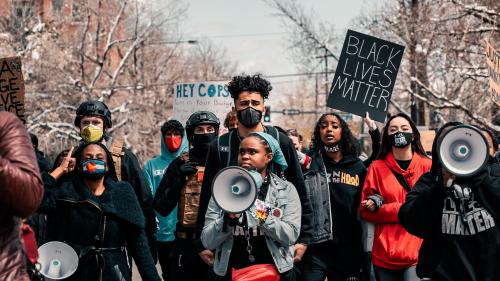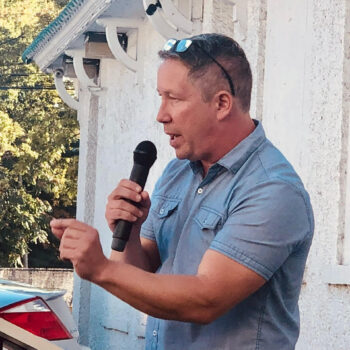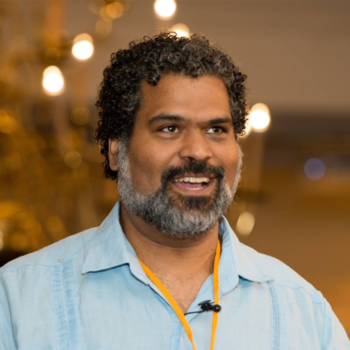In his 1998 article “The Last Stop Sign,” the Oakland-based organizer Gary Delgado issued a friendly provocation: organizers must directly take on race and racism.
The dominant traditions of community organizing at the time, especially as practiced by the leading national networks, prioritized issues that promised to unite neighborhoods and constituencies. The ubiquitous campaign to demand a new stop sign on a busy street was the exemplar. The most effective organizers were said to be “non-ideological”; they avoided controversial issues that might divide a group’s members. Racial “colorblindness” (celebrated across the political spectrum in the 1990s and early 2000s) was the default organizing position.
Delgado saw things differently. He wanted organizers — especially the white, male staff leaders who were often the arbiters of “good organizing” practice — to stop dodging controversial issues associated with race. Delgado wasn’t just asking individual organizers to talk about their racial identities and interpersonal struggles. He called for organizing as a field to “proactively address issues of race, class, gender, corporate concentration, and the complexities of a transnational economy” and to “use analytical and ideological tools to develop political vision.” Welfare. Housing. Health care. Community safety. Immigration. Jobs. All our big issues are about race, he argued, even if race isn’t mentioned explicitly. Hiding from that reality only stands in the way of building the effective multiracial movements we need. Delgado expressed the stakes clearly: “If community organizing is to live, it must change.”
Organizers of color — many trained by Delgado and others at the Center for Third World Organizing (CTWO) — kept pushing the field to face racism squarely, to acknowledge questions of identity and culture, to address racialized structures of power, and to take on fights at a bigger scale than those associated with winnable neighborhood issues. Powerful groups on the right set their sights much higher than putting up local stop signs; we had to as well.
Today, nearly every community organizing group accepts the importance of centering racial justice. The events of the last decade in particular — Ferguson, Standing Rock, Flint, the election of Trump, and so much more — have shattered the myth of colorblindness and post-racialism. As longtime collaborators of Delgado’s — trained and developed in several of the organizations he helped form, Center for Third World Organizing (CTWO) and the Applied Research Center/Race Forward — we welcome these shifts.
Yet in our experience, these commitments to racial justice often don’t translate into effective organizing praxis. To the contrary, many groups find themselves paralyzed in painful internal conflicts, with staff directing their energy and frustration at one another rather than forging cultures of growth and solidarity or developing strategies that enable them to make change externally. To be sure, attending to differences in politics, experience, and strategy are a crucial part of social justice work. But when they are divorced from member-driven campaigns to build power, they leave us ill-prepared to address the growing conditions of racial violence and inequality that shape our world.
Just as Delgado called for organizing to take racism head-on, we call for organizing to move from racial justice principle to racial justice practice rooted in member-driving power building.
Where We Get Tripped Up
Twenty-five years ago, the debate was around whether to address race. Now, the challenge is how to address it.
Just about every day, we hear from organizing groups that are struggling when it comes to race. These are organizations that are committed to multiracial organizing and that have made racial justice a core part of their strategy. Many are led by people of color. Yet race often comes up in these organizations not as an impetus for building community power but as a challenge to their cohesion and a distraction from their racial justice missions. Lacking a clear ideological anchor or strategic grounding, staff leaders often don’t know how to respond. The result is dysfunction, missed opportunities, and practices (like calling out individual acts of racial bias divorced from systemic analysis) that undermine racial justice goals instead of advancing them.
Here are a few examples we’ve witnessed:
-
An organization uses a version of “progressive stack,” which, instead of encouraging staff of color to speak, prevents some white and Asian American staff from engaging in staff conversations. The stack is used as a rigid rule rather than a tool to an end. As a result, an effort to center Black and Indgenous experiences turns into a practice that leaves some staff feeling unable to contribute to the discussion. Staff tension and internal conflict increase, and the organization’s impact suffers.
-
A white staff person in one organization confronts a Native American leader, accusing them of “anti-Blackness” for talking about tribal sovereignty without discussing Black people. This incident illustrates how new frameworks for addressing race can shut down learning and exchange when framed as a zero-sum competition between separate groups. Rather than collectively discussing and exploring the centrality of Native sovereignty, confronting anti-Blackness, and brainstorming how the group’s organizing could address both, the staff engaged in a conversation that devolved into personal condemnation separate from any engagement with members or campaign strategy.
-
A group’s multiracial staff of organizers resist setting goals or showing up on time, arguing that these standards reflect “white supremacy culture.” The organization has a mix of effective and rigorous work expectations. Leadership can be rigid at times and tough on the staff. But the lead organizer, a Black man, feels accused and undermined by his staff organizers. The organizers stop meeting their outreach goals. The organization spends hours in internal negotiations about work expectations as the work suffers. Staff trust hits an all-time low.
-
A community organization hires a talented organizer into an established chapter. Both the organizer and the local member leaders are people of color. The organizer engages the leaders in a discussion of policing and says defunding the police is the way to go. The leadership disagrees. The organizer tells their supervisor that the local leaders aren’t aligned with the organization’s mission and should be bypassed. The organization adopts defund as their position over local objections, driving some members out instead of investing in a longer-term process of education and alignment.
-
Some staff at a longstanding organization refuse its model of multiracial organizing. One Black organizer announces that they won’t doorknock anyone who isn’t Black. The organization has not explained the rationale for their multiracial organizing model and steeped their staff in it, so individual staff act on their own conclusions, independent of any collective discussion about how differing models (including autonomous Black organizing) extend from particular analyses about history, politics, and power. Rather than discussing these issues as political and strategic questions, the staff reduces the question to a simple moralism, in which multiracial organizing is framed as inherently compromised. Their supervisor is forced to either challenge the refusal to carry out their staff role or let it slide, undermining organizational strategy and staff standards. The organizer only grows more frustrated, and the group’s work suffers.
Some of the issues these stories raise concern internal organizational dynamics. Who holds power and decision-making authority? How do we resolve racist behaviors and systems within our organizations? How do we ensure that the harm and humiliation many of us have suffered because of racism and colonial violence are not meted out against others who are in close proximity? Ideally, these stories would also engage the question of how we hold open the possibility of learning and growing together, making mistakes in one another’s presence and directing our collective will toward winning material changes in the world, rather than against one another.
More broadly, these stories surface questions revolving around the terms and principles on which multi-racial organizing should take place, including the concern that the very specific and material conditions of anti-Black racism will be lost in broad discussions of racial justice. They also turn on how organizations work through differences around ideology, political analysis, and program, both within the staff and between staff, leaders, and members.
These are real challenges that each organization must address. Yet organizations often limit their focus to personal attitudes and interpersonal dynamics, neglecting the structural analysis that is so central to our work and strategies. The focus on individual characteristics and behaviors slides easily into essentialism, the inaccurate and divisive idea that there is a set of traits and values inherent in one’s racial identity. This understanding of race undermines an organizing theory of change and a focus on member-driven power building.
We take it as a given that people within progressive organizations can embrace racist beliefs and do harm to one another. This is the sad but utterly predictable consequence of being socialized in institutions (education, housing, media, etc.) saturated with racism. The power dynamics of our organizations can be filled with oppressive actions and systems, which must be challenged and remade. But these dynamics cannot be productively addressed though individual conflicts and confrontations. When the organization’s racial justice mission is reduced to pursuing and prosecuting such conflicts, few of us will remain, and no communities will be in any better position to challenge systemic racism and make change in people’s lives.
Organizations that adopt racial justice principles must ensure that they also invest in sustained forms of leadership, staff, and member development to create a shared understanding of race and racism (and gender or class for that matter). Such efforts can guide us forward. In the absence of such commitments, we fear groups will continue to direct their focus toward individual conflicts within the organization at the expense of addressing the racialized structures and conditions that foreclose life for so many.
Thoughts on a Path Forward
When Gary Delgado issued his provocation to organizers twenty years ago, he didn’t just take them to task and leave it at that. He and his colleagues at Race Forward (then the Applied Research Center) — along with a broader circle of organizers, including the three of us — rolled up our sleeves to help organizations create cultures and practices that allowed staff and members to tackle race and challenge one another, all with the goal of learning together and building solidarity. The organizational culture was a lot more calling-in than calling-out.
This helped many organizations create what we think is a foundational element of a racial justice program: a clear racial justice politics. That’s not just a values statement written up in a memo and lost in a folder somewhere on Google Drive or a web page decrying police killings. It’s a vision of solidarity, an understanding of the racial impacts of policy demands, and a careful program of power-building that leaders and staff are steeped in and that they come back to again and again as a touchstone. It requires the integration of a racial justice analysis, a clear strategy for change, and an organizational culture that lives stated values and navigates emerging trends.
Building a team around this vision and this politics is key. To navigate tough questions and challenges (even interpersonal conflict), that team must be aligned around politics, values, and trust. Creating that team doesn’t happen overnight. It requires organizational capacity and dedicated resources.
To build a strong racial justice program, we believe organizations also need to establish a culture that encourages people to challenge one another with a focus on collective learning and self-reflection, as opposed to shaming. Really vibrant organizations meet people where they’re at and then help them move to a shared set of values and analysis.
And, of course, none of this matters if we cannot create opportunities for staff and grassroots leaders to act on the organization’s racial justice politics through power-building strategies, focusing their energy externally on dismantling systems of oppression. In short, groups need to measure their progress toward racial justice by their impact on racial justice in our communities, not just inside our organizations.
Clearly, no organization is perfect when it comes to the complex and thorny issues of race and racism. Still, there are some organizational practices and principles from which we can learn. Virginia Organizing (VO) is a statewide multiracial membership organization with a 25-year commitment to racial justice. For more than two decades, the organization has run “dismantling racism” workshops for all new members.
Virginia Organizing is clear about its racial justice commitment, even in the majority-white counties that several of its chapters are in. That commitment is not only about internal operations and practices but also about ongoing external racial justice policy goals. Local chapters oppose armed police in schools, fight for refugee resettlement, and have led the charge in taking down Confederate monuments. For well over a decade, Virginia Organizing chapters fought for voting rights for formerly incarcerated people, who are disproportionately Black men in Virginia. The organization has aided hundreds of individuals to regain voting rights through the Byzantine process in the state and was critical in getting Governor Terry McAuliffe to restore voting rights to more than 200,000 formerly incarcerated people in 2016.
This groundwork was crucial for the organization in 2019, in the wake of the revelation of Governor Northam posing in blackface in a college yearbook. Virginia Organizing had an internal process that led the organization to call for Northam and other state leaders to make amends for their racist actions with a set of concrete policies and practices. This was not an easy decision. Many of VO’s state allies were uncertain as to how to hold the Governor accountable, as he was seen as an ally to a number of progressive causes. In fact, many Black Virginians backed the Governor in the face of right-wing attack.
Virginia Organizing was able to navigate a discussion internally among staff and members in order to come up with a public approach that was principled, unifying, and invested in the broader goals of building power. No simple task. Lesser debates have torn organizations apart. One key to the process was that staff did not make the decision on the organization’s stance; it was member leaders who decided. Members and staff shared a common language and framework for understanding race and racism. Staff and members agreed that they didn’t want just symbolic action or individual shaming. Real change in policy was the way to make amends.
Communities for Our Colleges (C4C) in Washington state provides another example. Launched in 2020, C4C is a campaign to transform Washington state’s community and technical colleges. They have already won important new legislation to fund equity programs for community colleges and are now campaigning free tuition and wrap-around services. The effort is student-led but also involves faculty and staff and draws on a broader coalition that includes organizations focused on racial equity in education. From the start, C4C staff believed the coalition needed to apply race and class analysis. Their concern was that C4C might win representational concessions without building student leadership or getting at systemic material issues affecting students. So, as they began assembling the coalition, they discussed this race-class framework individually with members. Then, in the coalition’s initial meetings, the group considered and refined a statement of principles that fleshed out that framework.
This groundwork has given the coalition tools for addressing tensions as they arise. One instance involved asking a white coalition member, behind the scenes, to speak less in coalition meetings to give more room to others. Another occurred during a legislator-meeting debrief, when a coalition member said the group should challenge the lawmaker’s aides for their “whiteness” and criticized the coalition for not focusing on defunding the police. Concerned these comments could derail and divide the coalition, the campaign director steered the conversation back to the coalition’s principles and purpose — equity for community colleges — noting that the policing issues the member had raised required deeper conversation if the coalition wanted to do more than pay lip service.
The campaign faced another challenge after a hearing on its legislation, during which a Republican lawmaker attempted to bait an Asian American student over affirmative action — a clear attempt to split the coalition. The coalition didn’t immediately know how to respond to the provocation, and they took a few hours to deliberate. One option was to “call out” the legislator and demand an apology. But the coalition realized that taking the bait wouldn’t help them build their power. Instead, they reached out to the committee chair, who responded with a commitment to move the legislation forward. The coalition was able to turn the crisis into an opportunity, but only because they’d built trust around their commitment to racial equity and remained focused on their strategy while being principled about their racial justice politics.
Some Lessons
A few lessons emerge from these examples: 1) when members and leaders are fully informed and involved it keeps staff from getting way out ahead of the base; 2) long-term commitment to education and leadership development pays dividends; 3) having clear racial politics and analysis before a crisis is important to weather the storm; and 4) it is crucial for organizations to take action externally on their racial justice politics and win change that improves people’s lives.
Gary Delgado’s warning that organizing must change still holds true today. Racial justice is increasingly embraced across our movements, but the strategic work to live up to that vision is still all too lacking.
Again, there’s no magic bullet or formula. But taking on systemic racism requires more than declaring our opposition to racism or accusing one another of white supremacy. It requires social movements to move from principle to practice and to develop the organizational capacity to wield coherent and powerful racial justice politics.



